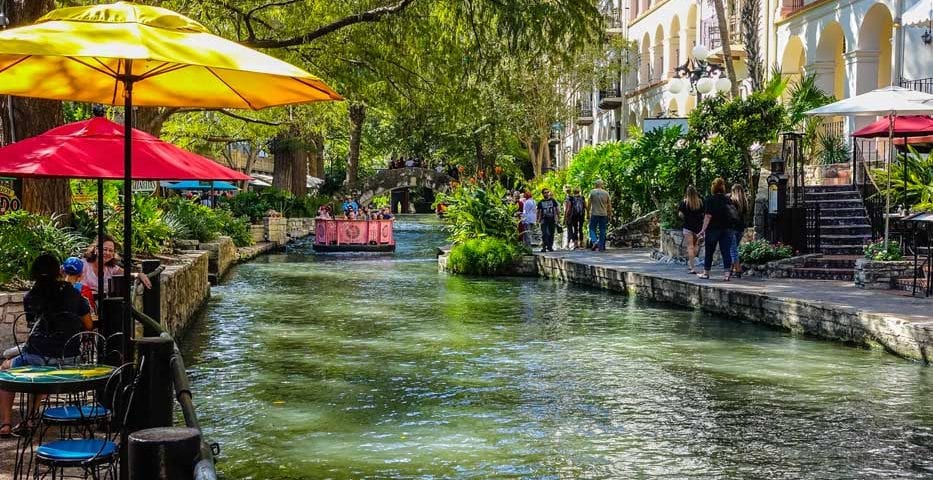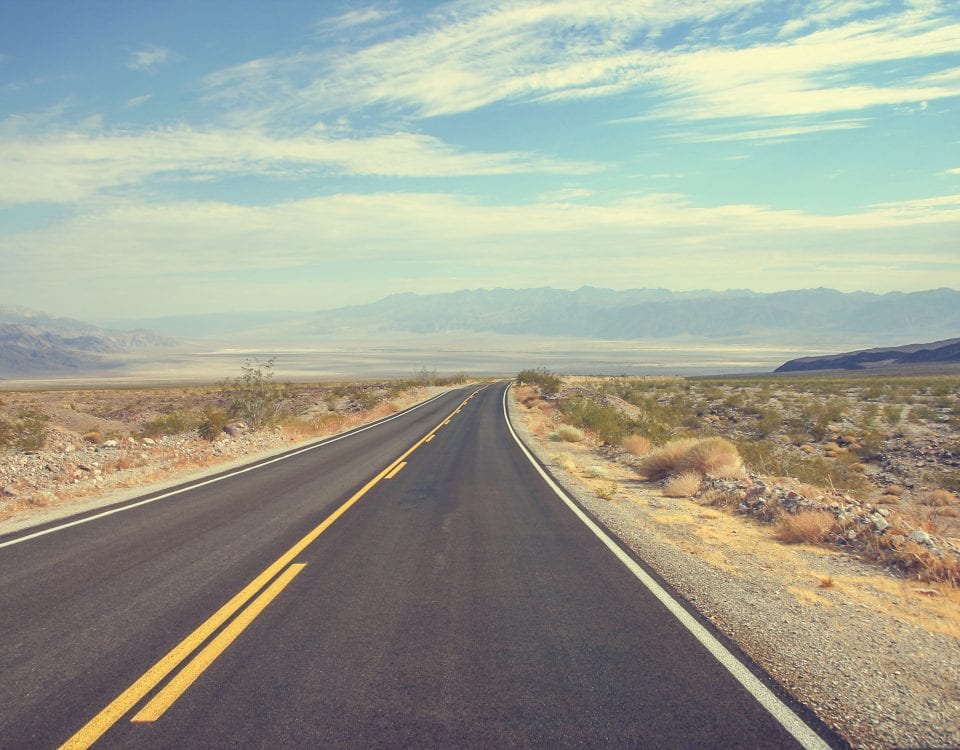
Day 8: Weirdness, Cheer and Fixer Uppers on the Road to Dallas
March 27, 2021
Day 6: Earth, Wind and Oil
March 25, 2021Most recently updated on March 7, 2024
Driven on March 27, 2022
Originally posted on March 26, 2021
There’s not much actual driving time today, but there’s a lot to see at our final destination.
So, today’s adventure begins by taking Highway 70 south out of Sweetwater until it merges with Highway 277.
In a little more than an hour, we cut through San Angelo, a town of 98,000 people that sits at the merger of three branches of the Concho River in the middle of Texas.
The town was founded in the 1860s across the river from the Fort Concho army post. This facility was one of several dozen forts constructed in Texas to help protect the region against attack from local tribes. It was built in 1867 and deactivated in 1889.
At the Fort Concho National Historic Landmark near the center of town, the history of the 40-building fort that once covered 1,600 acres is on display. That includes the history of the fort’s cavalry units, mounted troops and Black enlistees who were known as “Buffalo Soldiers.” Those units consisted of African-American soldiers recruited after the Civil War to protect settlers, stagecoaches and railroad crews as well as capture cattle rustlers in the Western frontier.
As it grew, San Angelo developed into a trade center for ranchers and farmers. It eventually became a major cattle market as well as the largest sheep market in the country, known especially for its inland wool and mohair products.
The city was also known as a somewhat lawless town with brothels, saloons and gambling houses. It was apparently wild enough that soldiers at Fort Concho would not leave their fortress after dark. Miss Hattie’s Bordello Museum near downtown recounts the history of one brothel that opened in 1902 and actually operated until 1952 until it was shut down by Texas Ranger investigators.
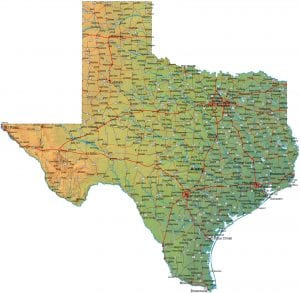
In the early 1900s, people with tuberculosis were sent to a treatment center in San Angelo to recover in the area’s warm weather.
Goodfellow Air Force Base was established during World War Two to train pilots. The base is still on the eastern side of town and is utilized mostly for military intelligence training as well as to provide firefighting instruction for all branches of the military.
In the mid-1900s, the city was also a regional outpost for telephone companies.
Today, San Angelo’s economy is mostly driven by the oil industry from the nearby Permian Basin. Companies here provide services for those working in the oil fields. There’s also more than 100 manufacturing firms making products such as denim jeans and electronics.
Cattle remains a major economic component.
The Producer’s Livestock Auction is the largest sheep and goat market in the United States. The San Angelo Stock Show and Rodeo, which began in 1932, hosts one of the world’s largest rodeos in terms of contestant entries.
The San Angelo YMCA is a busy contributor to the community here. In late March 2021, the organization launched a child hunger program at three Head Start centers to provide food for youngsters on weekends. The project was funded by a $25,000 grant from Atmos Energy. You can read more about hunger in the United States in this special Spotlight feature on our site.
The musical group Los Lonely Boys, which consists of three brothers from the Garza family, is from San Angelo. They’re best known for their song, “Heaven.”
Hall of fame pitcher Greg Maddux is one of eight Major League Baseball players from San Angelo. Maddux was born here in 1966.
Actor Matthew McConaughey is part of the culture in this area of Texas. His brother owns a ranch about 45 miles outside of town. McConaughey provided a thrill for employees at a San Angelo Whataburger in 2019 when he showed up at the drive-thru window to order some hamburgers. Yes, he did his “Alright, alright, alright.”
As we reach the south side of San Angelo, we turn east on Highway 87 and see more of the countryside that McConaughey must still enjoy.
A little more than an hour later, we reach the town of Brady.
We are truly in the heart of Texas as Brady is near the geographic center of the state and incorporates that fact into its marketing efforts.
The town of nearly 5,000 people was settled in the 1870s as a ranch community. The ranchers in the region used to drive their cattle from here to Kansas and other markets.
The Fort Worth and Rio Grande Railway arrived in 1903 with the Gulf, Colorado and Santa Fe Railroad coming through in 1912.
Brady remains a farming and ranching community as well as a shipping center. It also has a mohair combing plant.
The town is known for its world championship goat barbecue cookoff that’s held during Labor Day weekend. More than 13,000 people from all over Texas attend the event in a typical year.
There’s also the Heart of Texas Historical Museum that details the history of Brady.
—————————————
You can make good time as you continue south on Highway 87 in the midst of Texas Hill country.
This region of the state features the rugged limestone hills that separate the coastal plains from the Edwards Plateau. It’s known for ranching and farming but also has a tourism component due to its available hunting, fishing and camping.
The drive through this region of central Texas provides a landscape of pleasant rolling hills, chaparral, cotton farms, windmills and pastures for cattle, sheep, goats and horses.
About an hour out of Brady, we approach the city of Fredericksburg.
Unlike a lot of other Texas towns on our route, this community of 11,000 people is predominantly Caucasian. About 78 percent of residents are listed as white while 20 percent are Hispanic or Latino. The median age is 51 with a median annual household income of $56,000. The poverty rate is 11 percent.
During the past century, a teacher and a first lady have had unexpected influences on Fredericksburg’s economy.
In 1921, Benjamin Lester Enderle, who taught math and science at the local high school, planted five peach trees on his 14-acre property just east of town.
Using his scientific knowledge, he developed a durable variety of peach that could withstand shipping. By 1925, he and his wife had several hundred trees on their land.
Enderle marketed his fruit through H-E-B grocery stores in Austin and San Antonio. By 1935, Enderle had 5,000 trees on more than 150 acres.
Enderle was a charter member of the Gillespie County Peach Growers Association and is credited with starting the peach industry in central Texas.
Fredericksburg is considered the Peach Capital of Texas and still boasts a number of peach growers.
Fredericksburg also became a center for wildflower seeds after some inspiration from Lady Bird Johnson. The former first lady had an affinity for the environment since she was a child. After her husband, President Lyndon Johnson, left the White House, she continued those efforts.’
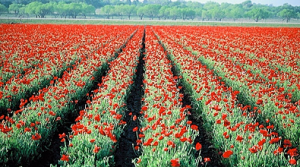
Part of the beauty of Wildseed Farms in Fredericksburg, Texas.
In 1982, she and actor Helen Hayes founded the Lady Bird Johnson Wildflower Center in Austin, Texas, as part of an effort to preserve native plants and natural landscapes.
In the early 1980s, John R. Thomas owned a turf seed business in Fredericksburg area. At that time, he started to notice people stopping on highways to admire the wildflowers.
So, Thomas established Wildseed Farms in 1983 a little southeast of Fredericksburg. It now is a 200-acre facility and is the largest working wildflower farm in the United States. The facility has walking trails through its wildflowers that the public can enjoy at no charge.
Lady Bird Johnson used to visit the farm several times a month. One of her favorite flowers, the showy primrose, is planted in her honor at the front of the property.
The Peach Basket General Store in downtown Fredericksburg is a good mix of Thomas’ and Enderle’s passions.
The store was established in 1977 to sell peaches from local orchards. It has evolved into a general store that sells a variety of peaches as well as peach salsa, peach candles and peach hand soap. It also carries wildflower honey, whole bean coffee and even its own brand of cannabidiol.
Grace Harrison, a cashier at the store, told us during our March 2022 visit that business has been picking up since the COVID-19 pandemic eased, but the town remained busy even during the restrictions.
“We’re always busy here,” she said.
She added that people from all over the world come into the store. On this day, she had already talked to three people from Europe.
Near the store is the National Museum of the Pacific War. It’s the only museum in the continental United States focused on the oceanic battles with Japan during World War Two.
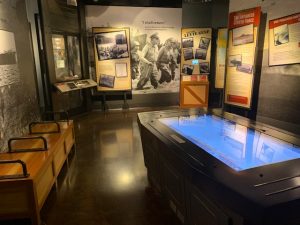
The National Museum of the Pacific War in Fredricksburg, Texas
The 50,000-square-foot complex set on 6 acres has exhibits that include a gallery devoted to Admiral Chester W. Nimitz, commander of the Pacific fleet, as well as a Pacific Combat Zone theater and a Plaza of Presidents.
The museum is here for the simple reason that Admiral Nimitz was born in Fredericksburg in 1885.
During our visit in March 2022, we talked with Steven and Judith Morgan, who live in a nearby town in Texas. They had tried several times to visit the museum but couldn’t get tickets due to limited capacity during the COVID-19 pandemic. They finally got in on this day and were delighted with what they found. They both said the museum provides a detailed explanation of an important part of U.S. history.
Not too far from this complex is the Pioneer Museum. The 3.5-acre facility is designed to preserve the history of the town’s German beginnings.
Fredericksburg was founded by German immigrants in 1846 and named after Prince Frederick of Prussia. The first 120 settlers planted corn and built storehouses as new groups of German transplants arrived.
The new residents nicknamed their community Fritztown and started to speak the now-dying dialect known as Texas German, which the settlers used because they refused to learn English.
The demographics of the town began to diversify with the arrival in 1913 of the San Antonio, Fredericksburg and Northern Railroad. It eventually became a manufacturing center for products such as furniture, cement and mattresses. The town also developed a tourist trade with its hunting and fishing.
You can also see the early German influence at a number of businesses downtown, including the Gastehaus Schmidt lodging facility as well as the Hoffman Haus bed and breakfast inn.
A popular lunch and dinner stop is The Auslander, a Bavarian-themed restaurant that specializes in German cuisine.
—————————————–
We continue southward on Highway 87.
It doesn’t take long to meet up again with our old friend Interstate 10 as we head east to San Antonio.
An hour after departing from Fredericksburg, we reach this city of nearly 1.5 million people. The Texas metropolis is now the seventh most populous city in the United States and the second most populated in Texas, behind only Houston.
About 65 percent of San Antonio’s residents are listed as Hispanic or Latino with 22 percent counted as white and 6 percent listed as Black.
That population is expected to continue to grow at a rapid pace.
A report released in March 2022 stated that the San Antonio area had one of the largest population increases of any region in the country between July 2020 and July 2021. Another report in March 2023 stated the San Antonio’s population grew more quickly than any other major U.S. city during the COVID-19 pandemic.
The city faces some economic challenges as it grows.
The median annual household income is $59,000 with a poverty rate of 17 percent. San Antonio incomes are $14,000 below the median for the state of Texas. The lower incomes are offset somewhat by a cost of living that is 10 percent below the national average.
There is also the issue of home prices. The median price for a single-family home here is around $250,000, about $170,000 below the national average.
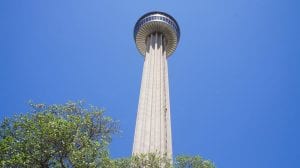
The Tower of the Americas in San Antonio, Texas. Photo by Pixabay.
Before we get too settled here, let’s get a wide perspective of the city.
For that, we stop at the Tower of the Americas near downtown. The tourist attraction is basically a 750-foot tower that includes exhibits as well as a 4D theater. However, the main selling point is the 360-degree observation deck where you can see all of San Antonio in every direction.
The first known Europeans to visit the region were Spanish explorers in 1691. The Spanish founded the city in 1718.
In 1731, a group of 56 people from 16 families from Spain’s Canary Islands emigrated to San Antonio. They reportedly brought with them their recipes for chili. The spicy dish was later popularized in the late 1800s by the city’s “Chili Queens,” women who sold their chili con carne from open pots in the city’s plazas. Historians credit this chili culture as being one of the origins of the Tex-Mex style of cooking as well as the food trucks that are popular today.
San Antonio was established during the Spanish Colonial Era with five missions built along the river that flows through town.
One of those missions was the Alamo, which sits just a few blocks north of the Tower of the Americas.
The circumstances that led the famous battle there began in December 1835 when a group of Texan combatants took control of the complex, which had been converted to a fort, during Texas’ battle for independence from Mexico.
The Mexican armed forces retaliated a few months later. From February 23 to March 6, 1836, a battle raged between 200 Texans holed up inside the Alamo against thousands of Mexican soldiers led by Gen. Antonio Lopez de Santa Anna.
Eventually, the Mexican forces overwhelmed the fort and all the Texans inside were killed. The casualties included Davy Crockett, the frontiersman and former congressman, and Jim Bowie, the inventor of the knife that bears his name.
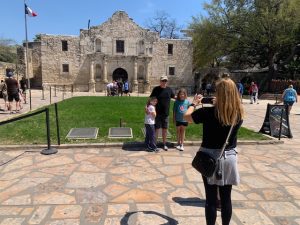
Tourists at The Alamo in San Antonio, Texas, in March 2022
“Remember the Alamo” was a battle cry for Texans as they eventually drove out Mexico’s forces and established an independent republic that lasted for about 10 years before Texas became part of the United States.
During a visit by 60 Days USA in March 2022, a couple hundred people circled around the Alamo, some waiting for their turn to go inside while others read the plaques all around the fortress and took photos out front.
Nancy and Francis Cole were here from Buffalo, New York, as part of a visit with their long-time friends Kenny and Sharon Peterson, who now live in San Antonio. Nancy said she visited the Alamo once when she was 12 and wanted to see it again. Her husband had never seen the site.
Darrin Huff was in town from Spokane, Washington. His stay in San Antonio was short, so he made sure stop by the historic site.
“When you think San Antonio, you think Alamo,” he told 60 Days USA. “I’m here, so I gotta see it.”
A U.S. military presence was established during the 1840s and the armed forces are still a major part of the city. Fort Sam Houston, which first opened in 1878, is the headquarters of the U.S. Fifth Army. Three Air Force bases are also nearby. About 85,000 military personnel now live in the San Antonio area.
San Antonio also has a cattle history. In the latter part of the 1800s, the region was a starting point for the Chisholm Trail, making it a center for herds being transported to Kansas. One of the ranchers was Samuel Maverick, who let his unbranded cattle roam the countryside in the 1840s. Cattle without a brand was rare then, so his livestock were labeled as “mavericks.” That phrase eventually became the present day term to describe someone who is an independent thinker.
In the latter part of the 1800s, the city also developed a wool market. During this time, the city also saw an influx of German immigrants.
The arrival of the railroad in 1877 prompted more growth. By 1900, five railroads were crossing the town.
The train service sparked a boom in manufacturing. In the 1880s, the city had a large flour mill, an iron works, a brewery and a cement manufacturer. Between 1880 and 1890, the number of factory jobs grew from about 360 to more than 2,500.
Agriculture also began to prosper. Between 1880 and 1920, the number of farms in the region increased by 300 percent. Farm acreage more than doubled.
Processing and shipping facilities expanded to accommodate the agricultural industry.
In the early 1900s, immigrants from Mexico began to arrive to supplement the growing farm industry as the population of the city surpassed 50,000 people.
Agriculture, especially cotton production, continued to flourish in the 1920s.
However, the Great Depression of the 1930s cut deeply into farm production. So did an invasion of the boll weevil. Commerce and industry also took a serious hit.
It was, however, during the Depression that Fritos corn chips were invented here. It was in this depressed economy that Charles E. Doolin, a shop owner in town, began looking for a cheap snack to sell since sales of tortillas were decreasing. He stumbled upon a Hispanic man who was selling small fried corn chips called “fritos” at a gas station.
Doolin bought the patent and began making Fritos from his kitchen as his mother perfected the recipe. He even developed a special hybrid of corn that he paid local farmers to grow. Doolin opened a Casa de Frito in Disneyland in 1955 as well as a similar restaurant in Dallas. Before his death in 1959, Doolin partnered with Herman Lay and they developed the Frito-Lay brand. The rest is snack food history.
World War Two brought an economic revival as the city’s military establishments expanded and powered up.
The tech industry got its start here in 1998 when Rackspace opened for business. The firm is now one of the world’s largest managed cloud computing companies.
In 2003, Toyota broke ground on a $1.2 billion manufacturing plant on 2,000 acres just south of town. The Toyota Texas plant began operations in 2006. In September 2022, it began manufacturing a hybrid Sequoia SUV. The facility employs 9,400 people.
The economy in San Antonio today consists of medical research, aerospace, education, finance, information technology and tourism. There is also a growing cybersecurity industry.
In addition, a large portion of trade between Mexico and the United States passes through on the freeways that crisscross San Antonio.
The city has made a significant investment in upgrading its infrastructure with voters approving $1 billion in bonds between 2010 and 2020 to fix roads, libraries and other services.
In addition, the city has put a major emphasis on reviving and renewing its downtown sector.
There’s plenty to see in the core of San Antonio.
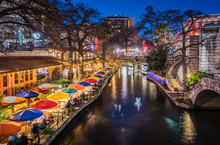
The River Walk at night in San Antonio, Texas.
Among other things, the downtown is part of the city’s large tourism industry that brings nearly 40 million visitors to town in a typical year and generates an economic impact of $15 billion.
One of the chief components of the tourism efforts is the River Walk. This pedestrian-oriented system consists of 15 miles of walking and biking paths that follow the San Antonio River through downtown. There are also boats that float down the canal.
The channel began as a flood control project in the 1920s. The first section of the walkway was completed in 1941. The walkways are actually one level below the city streets. The walk has been constantly upgraded and is now the largest urban ecosystem in the country.
An island near the Hotel Contessa is one of the main attractions along the walkway. The heart-shaped isle is actually a “root ball” of a cypress tree planted 100 years ago. It’s now the site of more than 200 weddings in a typical year and has earned the nickname “Marriage Island.” The island is said to bring good luck to the couples who wed there.
We stumbled upon one of these ceremonies on a Monday afternoon in March 2022.
A couple from Houston was saying their vows before some parents, two bridesmaids, a flower girl and a handful of family and friends. The short ceremony ended with a guitarist strumming “Here Comes the Sun” and a long kiss between the newly wed husband and wife. After a few photos, the couple did a FaceTime call with some folks who couldn’t make it to San Antonio.
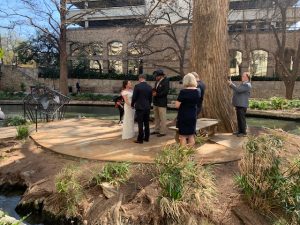
A wedding on Marriage Island along the San Antonio River Walk on March 28, 2022
The wedding was presided over by Darin Watson, an ordained minister who does 100 to 120 of these ceremonies on Marriage Island per year working through The Ministry at San Antonio.
Watson told 60 Days USA being an officiant never gets old.
“The ceremonies are life-changing events and I get to be part of it,” he said.
Watson said most of his couples are from out of town and a surprising number the previous year had been from Canada.
Another popular spot is The Pearl, a 22-acre district a couple miles north of downtown that’s filled with trendy restaurants and upscale shops. The Pearl district began in the 1880s, driven in large part by the presence of the Pearl Brewing company.
The redevelopment of The Pearl district began in 2001 after Pearl Brewing closed its doors. It’s developed into a hip neighborhood along the San Antonio River with more than 300 apartments, 13 retailers and 15 restaurants as well as museums and a botanical garden.
One dinner option is the Southerleigh Fine Food & Brewery, which prides itself on its coastal and southern cuisine as well as its craft beers.
Among the buildings in The Pearl is the new headquarters for Credit Human, a facility that uses geothermal energy and is labeled as the greenest building in San Antonio. The complex gets its heat from 150 geothermal wells installed on the site.
San Antonio boasts of a number of home-grown celebrities.
One of them is comedian Carol Burnett, who was born here and lived in the West Side neighborhood until she was 7.
Oliver North, a retired lieutenant colonel who served in the Reagan administration, spent 17 years as a Fox News contributor and for one year was president of the National Rifle Association, was born in San Antonio.
Norah O’Donnell, the CBS Evening News main anchor, grew up in San Antonio and attended MacArthur High School.
We’ll call it a wrap on Day 7.
Tomorrow, it’s a south-to-north trek passing through the state capital, a town revived by a home improvement show and a center for college cheerleading with our finish line at the Big D.

